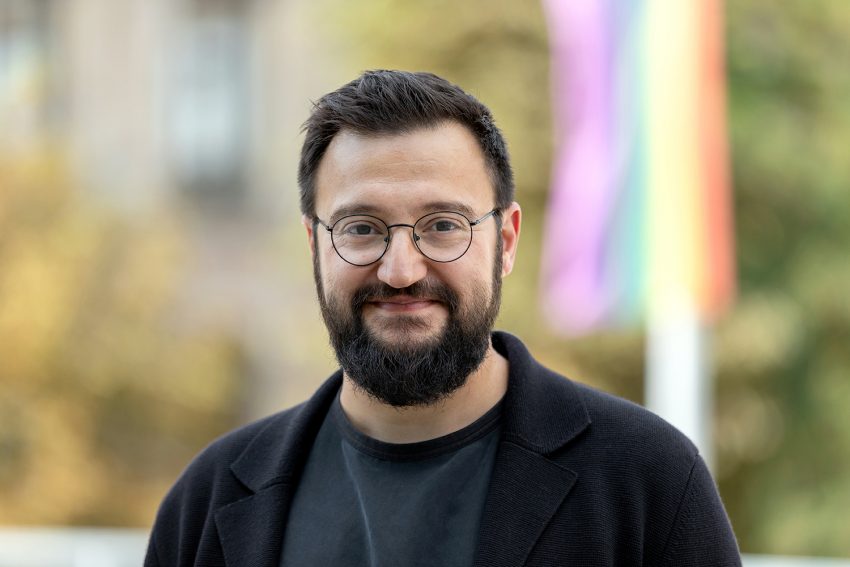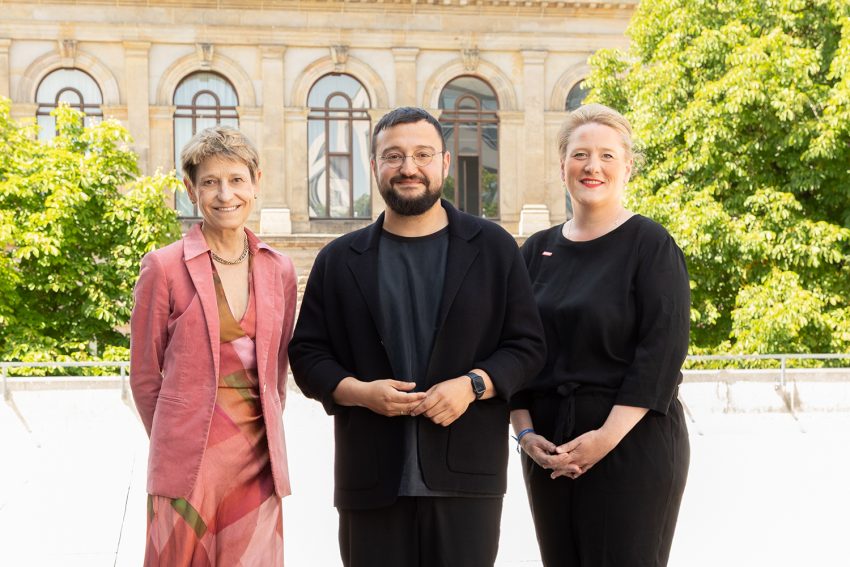“Architecture begins with seeing” Professor Fahim Mohammadi is the head of the new Institute for Methodologies of Design and Representation
“Hand drawing makes thinking visible.” For Professor Fahim Mohammadi, architectural representation is much more than a technique – it is the place where perception, attitude and design intertwine. Since 1 September 2025, he has headed the new Institute for Methodologies of Design and Representation and taken over basic teaching in this area. His goal: to teach students to look closely, allow for irritations and develop a position. In an interview with Heiko Jacobs and Bianca Loschinsky, he talks about active observation, international networking and the “Laboratory for Aesthetic Knowledge Production & Transfer”.

Professor Fahim Mohammadi heads the new Institute for Methodologies of Design and Representation. Photo credit: Kristina Rottig/TU Braunschweig
Professor Mohammadi, welcome! After ten years at the State Academy of Fine Arts in Stuttgart, you are now moving to our university. What are you looking forward to in Braunschweig?
I have always been impressed by the fact that architecture at TU Braunschweig is not considered in isolation, but in the context of many disciplines. The formation of Faculty 3 as a combination of architecture, civil engineering and environmental sciences was ahead of its time! In terms of my teaching, this means encouraging students to explore their own perceptions from the outset and uncover the structures that lead to them. Armed with the knowledge to grasp this perception in a creative and process-oriented way, they can develop their own attitude and contribute to interdisciplinary discourse. This forms the core of my creative and methodological contribution to basic teaching: sharpening perception, developing forms of expression, and passing on what has been learnt.
The new Institute for Methodologies of Design and Representation forms part of a larger structure, bringing together colleagues from various specialisms. My role involves strengthening the creative-methodological basis, providing students with the foundations on which they can develop and express their own positions.
From October, you will start teaching basic design and presentation. First-year students will learn how to observe and draw under your guidance. Could you explain what you mean by “active seeing” and how students will learn to “see”?
Active seeing is more than just registering impressions. It involves questioning one’s own perception while remaining open to irritations and surprises without any immediate purpose. Alexander Gottlieb Baumgarten, the founder of aesthetics as an independent form of knowledge, identified this type of perception alongside the purely rational.
Students will learn not only to record what they perceive, but also to use this as a starting point for developing a deeper understanding, gaining insight and taking a coherent creative approach. It is crucial that perception is translated into a form that can be reflected upon, developed further, and shared with others. It is also important that the curriculum allows time and space for this exploration.
What role does drawing by hand still play today? How much tradition do we still find in the teaching of architectural drawing?
Hand drawing remains an indispensable part of architecture, not as a nostalgic tradition, but because it makes the thought process visible. When you draw, your eye, hand and perception are connected directly. Looking reflectively at your own drawing reveals what you pay attention to and what you don’t, because drawing always acts as a filter. It reveals which structures you consider essential and which you overlook. Baumgarten’s idea of sensory cognition (Cognitio Sensitiva) emphasises that aesthetic practice enables us to perceive subtle differences that pure conceptual thinking would not grasp. In his Critique of Judgement, Kant emphasised that aesthetic judgement is how we decide what is worthy of representation. This is precisely what occurs in hand drawing: it not only trains the hand, but also hones the ability to evaluate what is perceived, differentiate, and render one’s attitude.
Tradition plays a role here, but not in the sense of mere preservation. Rather, hand drawing introduces students to an exercise that has shaped architectural education for centuries: seeing precisely, deciding and concentrating. Today, of course, we also have digital processes and machine vision at our disposal, but hand drawing remains a counterpoint: personal, immediate and irreplaceable in its ability to sharpen perception and enable self-reflection. Its lasting significance lies in this tension.
So when do students encounter digital content?
Very early on. Today, there is no other way to think about it. However, it is crucial that it complements the basics rather than replacing them. Without the ability to observe closely and reflect on what they perceive, people will only use digital tools, such as CAD, 3D modelling and AI-supported representation, in a superficial way. That’s why I think it’s important to lay a creative and methodological foundation first: seeing, perceiving, representing and communicating. Only then can digital processes build on this foundation and reveal their full potential.
We have very good conditions for this in Braunschweig, as there is technological excellence here. My task is to combine this with a sound basic education, ensuring that students understand digital tools as a conscious extension of their thinking and design, rather than using them unthinkingly.
During your previous professorship in Stuttgart, you established an extensive international network, including visiting schools in London and, most notably, ELIA, the European League of Institutes of the Arts. Will you continue this from Braunschweig? What opportunities does this open up?
To me, internationality is not an add-on, but an integral part of a university’s identity. Through my work on the ELIA board, I have gained insight into the strengths and challenges of countless European art colleges and architecture faculties.
This creates many opportunities for Braunschweig. For students, there are concrete opportunities such as international encounters, exchange programmes and joint projects. At the institutional level, there are also opportunities: ELIA is closely linked to higher arts education and the role of artistic processes in education as a whole. I would also explicitly include the perception of urban spaces and what has been and hasn’t been built. Through its Department of Architecture, TU Braunschweig participates in these European discussions.
I also consider it important that staff members participate in these discussions through symposia, academies and exchange programmes. Networking takes place not only at management level, but also through the people who teach and conduct research on a daily basis. This benefits TU Braunschweig as a whole, both internally and externally.

Professor Fahim Mohammadi with TU President Angela Ittel and Professor Elisabeth Endres, Department Spokesperson for Architecture. Photo credit: Kristina Rottig/TU Braunschweig
What are the main projects you will be working on at TU Braunschweig?
The central project is initially the establishment of the Institute for Methodologies of Design and Representation. Here, the basic teaching is to be strengthened and profiled as a design-methodological building block within the structure of many subjects, from building construction and building physics to architectural design.
At the same time, the LÆB – the Laboratory for Aesthetic Knowledge Production & Transfer – is being established. It takes an approach that exposes technological or social conditions – such as quantum technological phenomena, ecological crises and digital transformations – to aesthetic processes. Rather than explaining these topics scientifically, the aim is to examine them phenomenologically: what effect do they have on artists, architects and designers? How do they alter their perspectives, processes and products?The results, whether from student projects, collective research or individual work, in turn form aesthetically mediated approaches for society. They can be made visible in exhibitions, publications or other formats.
I also consider it important that the LÆB has a networking effect within the TU, acting as an interface between architecture, civil engineering and environmental sciences, as well as engaging with physics, computer science and cultural studies. This enables aesthetic research to engage with technical and scientific issues, showcasing Braunschweig as a place where these worlds are productively brought together.
What motivated you to focus on the field of architectural representation?
I have always been fascinated by the fact that architectural representation is much more than a technique for depicting. Representation is where perception, thought and attitude become visible. It determines what we consider essential, what we emphasise and how we understand connections. It is not an afterthought, but an integral part of the design process.
You could say that representation acts as a lens, sharpening our vision and making it legible to others. Added to this is my interest in irritations, breaks, glitches and playfulness. All of these things find their place in representation. Representation is not just a means to an end, but an independent form of knowledge, and it is in this area that I have found my place.
How would you describe your everyday work using three keywords?
If I had to summarise my everyday work in three keywords, they would be: observing, structuring and communicating.
Observing, because every day brings new situations, atmospheres and people that I take seriously and that guide me. Structuring, because all these impressions, tasks and projects have to be summarised and organised in order to be effective. And communicating, because ultimately it’s about sharing thoughts, attitudes and insights in such a way that they resonate with students, the university and society.
